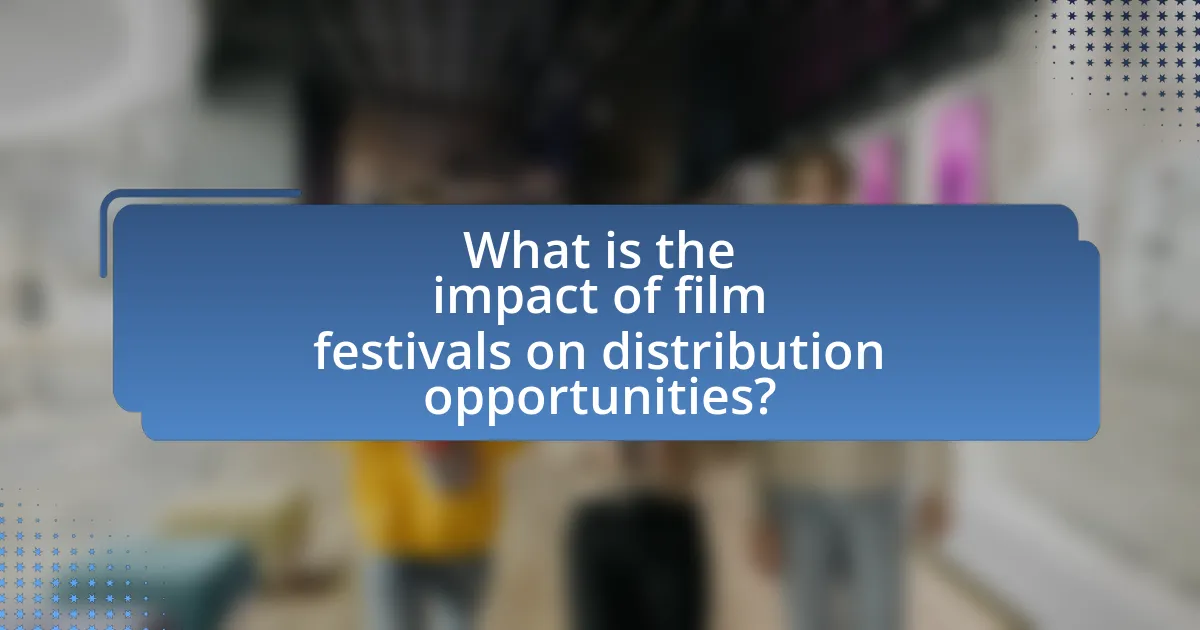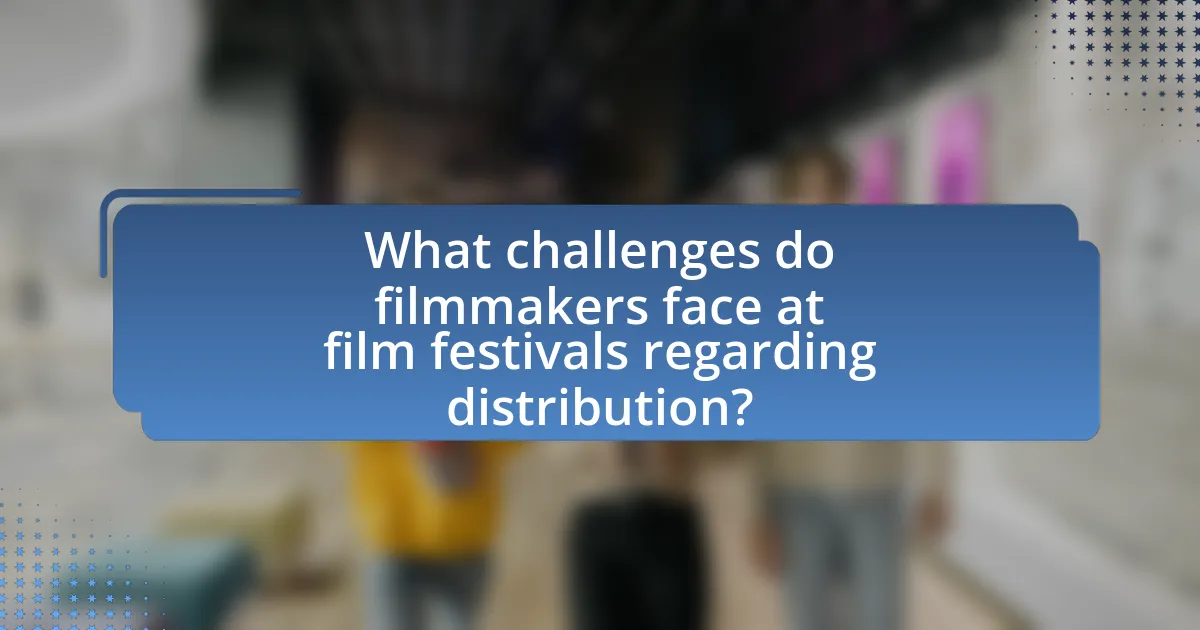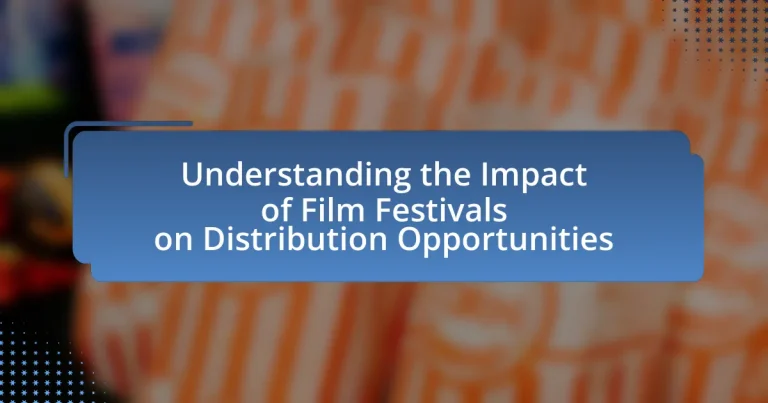Film festivals play a crucial role in enhancing distribution opportunities for filmmakers by providing platforms for visibility, networking, and audience engagement. They significantly increase the likelihood of securing distribution deals, with studies indicating that films showcased at festivals are 40% more likely to be picked up for distribution. The article explores how film festivals influence film visibility, the impact of awards on distribution deals, and the unique opportunities they present for independent filmmakers. Additionally, it addresses the challenges filmmakers face at festivals, strategies to navigate competition, and best practices for maximizing distribution opportunities through effective festival participation.

What is the impact of film festivals on distribution opportunities?
Film festivals significantly enhance distribution opportunities for filmmakers. They serve as platforms where films can gain visibility, attract industry professionals, and generate buzz, which can lead to distribution deals. For instance, films that win awards or receive critical acclaim at prestigious festivals like Sundance or Cannes often secure distribution agreements shortly after their screenings. According to a study by the University of Southern California, films showcased at festivals are 40% more likely to be picked up for distribution compared to those that are not. This demonstrates that participation in film festivals can be a crucial factor in a film’s commercial success and market reach.
How do film festivals influence the visibility of films?
Film festivals significantly enhance the visibility of films by providing a platform for filmmakers to showcase their work to industry professionals, critics, and audiences. These events attract media attention, which can lead to increased public interest and potential distribution deals. For instance, the Sundance Film Festival has historically launched the careers of numerous filmmakers and facilitated distribution agreements for films like “Little Miss Sunshine,” which was acquired for $10 million after its premiere. Additionally, festivals often feature awards that can elevate a film’s profile, as seen with the Academy Awards, where nominations can lead to a substantial increase in viewership and box office revenue. Thus, film festivals play a crucial role in amplifying the reach and impact of films in the competitive entertainment landscape.
What role does audience engagement play in film visibility?
Audience engagement significantly enhances film visibility by fostering a connection between the film and its viewers, which can lead to increased word-of-mouth promotion and social media sharing. Engaged audiences are more likely to discuss the film, recommend it to others, and participate in promotional activities, thereby amplifying its reach. For instance, films that actively engage their audiences through interactive screenings or social media campaigns often see higher attendance rates and greater media coverage, as evidenced by the success of films like “The Blair Witch Project,” which utilized grassroots marketing strategies to create buzz. This engagement not only elevates the film’s profile but also attracts the attention of distributors, ultimately improving distribution opportunities.
How do film festival awards affect distribution deals?
Film festival awards significantly enhance distribution deals by increasing a film’s visibility and perceived value. Winning or being nominated for prestigious awards, such as the Academy Awards or Cannes Film Festival accolades, often attracts the attention of distributors who are looking for high-quality content with proven audience appeal. For instance, films that receive awards typically experience a boost in marketability, leading to more favorable negotiations and higher financial offers from distributors. Historical data shows that films recognized at major festivals often secure wider theatrical releases and better marketing support, which can directly correlate with increased box office revenue.
Why are film festivals important for independent filmmakers?
Film festivals are crucial for independent filmmakers because they provide essential platforms for exposure, networking, and distribution opportunities. These events allow filmmakers to showcase their work to industry professionals, critics, and audiences, which can lead to increased visibility and potential sales. For instance, the Sundance Film Festival has historically launched the careers of numerous independent filmmakers, with films like “Little Miss Sunshine” and “Whiplash” gaining significant distribution deals after their premieres. Additionally, festivals often attract distributors looking for fresh content, making them vital for securing distribution agreements that can elevate a film’s reach and success.
What unique opportunities do festivals provide for indie films?
Festivals provide indie films with unique opportunities for exposure, networking, and potential distribution deals. These events attract industry professionals, including distributors, producers, and critics, who are actively seeking fresh content. For instance, the Sundance Film Festival has historically launched the careers of numerous indie filmmakers, with films like “Little Miss Sunshine” securing distribution deals shortly after their festival premieres. Additionally, festivals often offer awards and recognition, which can enhance a film’s visibility and credibility, leading to increased interest from distributors. The combination of audience engagement and industry presence at festivals creates a fertile ground for indie films to gain traction in a competitive market.
How do festivals help in building a filmmaker’s network?
Festivals help in building a filmmaker’s network by providing a platform for filmmakers to connect with industry professionals, peers, and audiences. These events facilitate networking opportunities through panels, workshops, and social gatherings, allowing filmmakers to meet distributors, producers, and other creatives. For instance, the Sundance Film Festival has been known to launch careers and foster collaborations, as many successful filmmakers attribute their networking success to connections made at such festivals. This environment encourages relationship-building, which is essential for future projects and distribution deals.
What types of distribution opportunities arise from film festivals?
Film festivals provide several distribution opportunities, including securing theatrical distribution deals, attracting interest from streaming platforms, and facilitating international sales. The presence of industry professionals, such as distributors and sales agents, at festivals creates a marketplace for filmmakers to showcase their work and negotiate distribution agreements. For instance, the Sundance Film Festival has historically led to significant distribution deals, with films like “Little Miss Sunshine” being acquired for theatrical release shortly after their festival debut. Additionally, festivals often serve as launchpads for films to gain critical acclaim, which can enhance their marketability and lead to further distribution avenues.
How do festivals facilitate connections with distributors?
Festivals facilitate connections with distributors by providing a centralized platform for filmmakers and distributors to interact directly. These events often feature networking sessions, panel discussions, and screenings that attract industry professionals, allowing filmmakers to showcase their work and engage with potential distributors. For instance, the Sundance Film Festival has historically been a launching pad for films that secure distribution deals, evidenced by the sale of “Little Miss Sunshine” for $10 million in 2006. Such interactions at festivals create opportunities for negotiations and partnerships that might not occur in other settings, thus enhancing distribution prospects for filmmakers.
What are the different distribution models available post-festival?
The different distribution models available post-festival include theatrical distribution, digital distribution, and hybrid distribution. Theatrical distribution involves releasing films in cinemas, which can generate significant box office revenue and enhance visibility. Digital distribution allows films to be released on streaming platforms, providing wider access to audiences and often lower costs for filmmakers. Hybrid distribution combines both theatrical and digital releases, maximizing reach and revenue potential. According to a report by the Independent Film & Television Alliance, films that utilize multiple distribution models can achieve higher overall revenue and audience engagement.
How do film festivals impact the marketing strategies of films?
Film festivals significantly influence the marketing strategies of films by providing a platform for exposure, networking, and audience engagement. These events allow filmmakers to showcase their work to industry professionals, critics, and potential distributors, which can lead to increased visibility and buzz around the film. For instance, films that receive awards or critical acclaim at festivals often see a boost in their marketing efforts, as evidenced by the success of films like “The Hurt Locker,” which gained traction after winning multiple awards at the Sundance Film Festival. Additionally, festivals serve as a testing ground for audience reactions, enabling filmmakers to refine their marketing messages based on feedback. This strategic positioning at festivals can enhance a film’s appeal and ultimately influence its distribution opportunities, as distributors are more likely to invest in films that have demonstrated audience interest and critical support.
What are the key factors that determine a film’s success at festivals?
The key factors that determine a film’s success at festivals include the quality of the storytelling, the originality of the concept, and the effectiveness of the marketing strategy. High-quality storytelling engages audiences and critics alike, often leading to positive reviews and word-of-mouth promotion. Originality sets a film apart in a crowded market, making it more likely to attract attention from festival programmers and distributors. Additionally, a well-executed marketing strategy, including social media presence and networking, can enhance visibility and increase the chances of securing distribution deals. Historical data shows that films with strong narratives and unique perspectives tend to perform better at major festivals, such as Sundance and Cannes, where competition is fierce.

What challenges do filmmakers face at film festivals regarding distribution?
Filmmakers face significant challenges at film festivals regarding distribution, primarily due to competition and limited access to distribution networks. The high volume of films presented at festivals creates intense competition, making it difficult for individual filmmakers to stand out and secure distribution deals. Additionally, many festivals prioritize established filmmakers or those with prior accolades, which can marginalize emerging talent. Furthermore, filmmakers often encounter barriers in connecting with distributors, as networking opportunities may be limited or overshadowed by larger industry players. According to a report by the Sundance Institute, over 12,000 films were submitted to the Sundance Film Festival in 2020, highlighting the fierce competition filmmakers face in gaining visibility and distribution opportunities.
How can filmmakers navigate competition at festivals?
Filmmakers can navigate competition at festivals by strategically selecting festivals that align with their film’s genre and target audience. This targeted approach increases the likelihood of attracting the right viewers and industry professionals, thereby enhancing networking opportunities. For instance, the Sundance Film Festival is known for independent films, while Cannes focuses on high-profile international cinema. Additionally, filmmakers should engage in effective marketing and promotion before the festival, utilizing social media and press releases to generate buzz. According to a study by the University of Southern California, films that actively engage with audiences prior to their festival debut often see higher attendance and interest from distributors. By understanding the festival landscape and leveraging promotional strategies, filmmakers can improve their chances of standing out in a competitive environment.
What strategies can filmmakers employ to stand out?
Filmmakers can employ unique storytelling techniques to stand out. By focusing on innovative narratives, such as non-linear storytelling or incorporating diverse perspectives, filmmakers can capture audience interest and differentiate their work. For instance, films like “Pulp Fiction” and “Eternal Sunshine of the Spotless Mind” utilized non-traditional structures to engage viewers, leading to critical acclaim and commercial success. Additionally, filmmakers can leverage film festivals as platforms to showcase their distinctive styles, as festivals often prioritize originality and creativity, providing opportunities for networking and distribution deals.
How does festival selection affect distribution chances?
Festival selection significantly enhances distribution chances by providing filmmakers with exposure to industry professionals, potential buyers, and audiences. When a film is selected for a prestigious festival, it often garners media attention and critical acclaim, which can attract distributors looking for new content. For instance, films that premiere at major festivals like Sundance or Cannes frequently secure distribution deals shortly after their screenings, as evidenced by the fact that over 60% of films that premiered at Sundance in recent years were acquired for distribution. This correlation between festival selection and distribution opportunities underscores the importance of strategic festival choices in maximizing a film’s market potential.
What are the common pitfalls filmmakers encounter at festivals?
Filmmakers commonly encounter several pitfalls at festivals, including poor networking, inadequate preparation, and misaligned expectations. Poor networking occurs when filmmakers fail to engage effectively with industry professionals, limiting their opportunities for distribution and collaboration. Inadequate preparation can lead to missed opportunities, such as not having promotional materials or a clear pitch ready, which can hinder a film’s visibility. Misaligned expectations often arise when filmmakers overestimate the likelihood of securing distribution deals, leading to disappointment and frustration. These pitfalls can significantly impact a filmmaker’s ability to leverage festival experiences for future distribution opportunities.
How can filmmakers avoid missteps in their festival strategy?
Filmmakers can avoid missteps in their festival strategy by conducting thorough research on festivals that align with their film’s genre and target audience. This targeted approach ensures that filmmakers submit their work to festivals that are more likely to appreciate and promote their film, increasing the chances of gaining distribution opportunities. For instance, the Sundance Film Festival is known for independent films, while the Cannes Film Festival focuses on international cinema, making it crucial for filmmakers to match their film’s style and content with the festival’s reputation and audience. Additionally, filmmakers should pay attention to submission deadlines and requirements, as failing to adhere to these can lead to disqualification or missed opportunities. According to a study by the University of Southern California, films that strategically select festivals based on their content and audience have a higher likelihood of securing distribution deals.
What are the consequences of poor festival planning?
Poor festival planning can lead to significant negative consequences, including financial losses, decreased attendance, and damage to reputation. Financially, inadequate budgeting and resource allocation can result in overspending or insufficient funds to cover essential expenses, leading to potential bankruptcy. Decreased attendance often occurs when marketing efforts are poorly executed, resulting in low visibility and interest among potential attendees. Additionally, a festival that fails to meet expectations can suffer long-term damage to its reputation, making it difficult to attract sponsors, filmmakers, and audiences in the future. For instance, a study by the University of Southern California found that festivals with poor planning often see a 30% drop in attendance compared to well-organized events, highlighting the direct impact of planning on festival success.

How can filmmakers maximize their distribution opportunities through festivals?
Filmmakers can maximize their distribution opportunities through festivals by strategically selecting festivals that align with their film’s genre and target audience. By participating in well-regarded festivals, filmmakers gain visibility among industry professionals, including distributors and sales agents, which can lead to distribution deals. For instance, the Sundance Film Festival has a history of launching independent films into successful distribution, with over 200 films sold in 2020 alone. Additionally, filmmakers should engage in networking during festivals, attending panels and events to build relationships that can facilitate future distribution opportunities. This approach is supported by the fact that 70% of festival attendees are industry professionals, providing a rich environment for potential partnerships.
What best practices should filmmakers follow when submitting to festivals?
Filmmakers should follow several best practices when submitting to festivals to enhance their chances of success. First, they must thoroughly research each festival’s submission guidelines and target audience to ensure their film aligns with the festival’s mission and programming. This alignment increases the likelihood of acceptance, as festivals often seek films that resonate with their specific themes or demographics.
Next, filmmakers should create a compelling submission package, which includes a well-crafted synopsis, a professional-looking poster, and a high-quality screener. A study by the Sundance Institute indicates that a strong visual presentation can significantly impact a festival’s selection process, as first impressions matter.
Additionally, filmmakers should consider the timing of their submissions. Many festivals have early bird deadlines that offer lower fees, and submitting early can help filmmakers avoid last-minute issues. According to the Film Festival Alliance, early submissions often receive more attention from programmers, as they have more time to review the films.
Networking is also crucial; filmmakers should attend festivals, engage with other filmmakers, and participate in industry events to build relationships that can lead to future opportunities. Research shows that personal connections can influence festival selections, as programmers often favor filmmakers they know or have met.
Finally, filmmakers should be prepared for feedback and rejection, using it as a learning opportunity to improve their work for future submissions. The experience gained from submitting to multiple festivals can enhance a filmmaker’s skills and increase their chances of success in the long run.
How important is the choice of festivals for a film’s success?
The choice of festivals is crucial for a film’s success, as it significantly influences its visibility, audience reach, and distribution opportunities. Selecting prestigious festivals, such as Cannes or Sundance, can enhance a film’s credibility and attract industry attention, leading to potential distribution deals. Research indicates that films showcased at top-tier festivals often experience higher box office revenues and increased chances of securing distribution contracts. For instance, a study by the University of Southern California found that films premiering at major festivals had a 50% higher likelihood of being distributed compared to those that did not participate in such events. Thus, the strategic selection of film festivals directly impacts a film’s overall success in the competitive market.
What role does a film’s marketing play in festival submissions?
A film’s marketing plays a crucial role in festival submissions by enhancing visibility and attracting attention from festival programmers and audiences. Effective marketing strategies, such as targeted social media campaigns, press releases, and promotional materials, can significantly increase a film’s chances of being selected for screening. For instance, films that utilize strong marketing tactics often generate buzz and anticipation, which can influence festival decision-makers. Additionally, statistics show that films with robust marketing efforts tend to secure better distribution deals post-festival, as they have already established a recognizable brand and audience interest.
What tips can filmmakers use to enhance their festival experience?
Filmmakers can enhance their festival experience by actively networking with industry professionals and attending panels. Engaging with other filmmakers, distributors, and potential collaborators can lead to valuable connections that may facilitate future distribution opportunities. According to a study by the University of Southern California, networking at festivals significantly increases the likelihood of securing distribution deals, as 70% of filmmakers reported that relationships formed at festivals led to professional opportunities. Additionally, filmmakers should prepare promotional materials, such as press kits and trailers, to effectively showcase their work and attract attention from distributors and audiences alike.
How can networking at festivals lead to better distribution deals?
Networking at festivals can lead to better distribution deals by facilitating direct connections between filmmakers and industry professionals, such as distributors and sales agents. These face-to-face interactions allow filmmakers to showcase their projects, receive immediate feedback, and build relationships that can result in distribution agreements. For instance, the Sundance Film Festival has historically been a platform where numerous films have secured distribution deals, with over 200 films sold in 2020 alone, demonstrating the effectiveness of networking in this environment.
What follow-up strategies should filmmakers implement post-festival?
Filmmakers should implement targeted outreach to industry contacts and audiences as a key follow-up strategy post-festival. This involves sending personalized thank-you notes to festival organizers, distributors, and potential collaborators, which fosters relationships and keeps the filmmaker’s project top-of-mind. Additionally, filmmakers should leverage social media to engage with festival attendees and share behind-the-scenes content or insights about their film, enhancing audience connection and interest.
Research indicates that maintaining communication with industry professionals can lead to distribution deals; for instance, a study by the University of Southern California found that 70% of filmmakers who followed up with contacts after festivals reported increased opportunities for distribution. This evidence underscores the importance of proactive engagement in maximizing the impact of festival participation.


